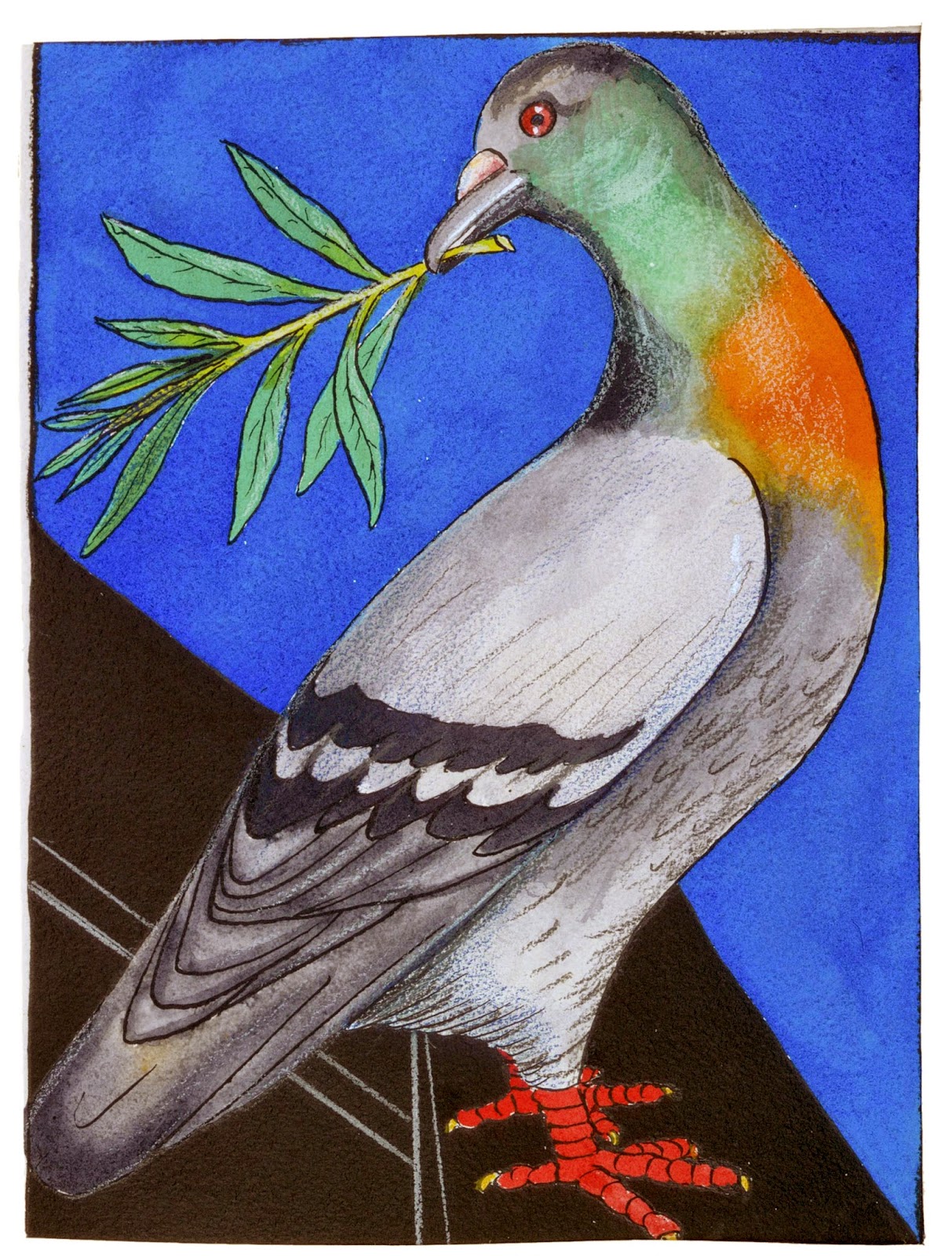
One of Carol Deutsch's 99 illustrations of the Bible
I am a proud descendant of the Jewish artist Carol Deutsch, my great uncle, who was murdered during the Holocaust. This week I had the honor of accompanying my aunt, Josette Deutsch-Nelson, Carol's niece and her son Philip Nelson on an emotional visit to Yad Vashem’s Museum of Holocaust Art, where Deutsch's works are on display. Josette was only five years old when she and her parents and two brothers fled Antwerp in May 1940, just days after the German invasion. Fleeing to Spain and eventually Portugal, they secured travel documents through the heroic efforts of the Portuguese Diplomat Aristides de Sousa Mendes, who was later recognized by Yad Vashem as Righteous Among the Nations.
We were warmly received by Niv Goldberg, Collections Manager of Yad Vashem's Museum of Holocaust Art, who presented Josette with a reproduction of Deutsch's illustrations and interviewed her. As she began to speak I was suddenly overwhelmed by the sensation that my aunt was an actual living link to the past. Interspersed with personal reflections and anecdotes, the events she described that took place over 70 years ago became as real to me as if they had happened just last week
While my father and his family succeeded in escaping from Belgium, Carol Deutsch along with his wife Fela and young daughter Ingrid were not as lucky. Initially forced into hiding under assumed identities in Brussels, Carol and Fela were ultimately betrayed, transported to concentration camps and murdered by the Germans. But Ingrid survived the war with her grandmother Regina Braunstein by hiding with a Catholic family in North-Eastern Belgium.
When Regina and Ingrid returned to the family apartment in 1945, they found that none of their possessions remained, the invading German forces had stolen everything. However, a large, meticulously crafted, wooden box adorned with a Star of David and a seven-branched menorah remained untouched.The box held a collection of 99 illustrations of the Bible produced by Carol Deutsch while in hiding in Brussels between 1941 and 1942, an impressive body of work that affirmed his Jewish identity which he created as a gift to his young daughter Ingrid in honor of her second birthday.
I felt so connected to my great uncle while viewing the display of his work. When faced with the heaviness of his fate and the possibility of his impending death his choice of what to bequeath to his precious daughter Ingrid was this masterpiece of Bible illustrations, the book upon which he was raised and upon which his values where shaped.
I can almost conjure up the image of the invading Nazis stumbling upon the wooden box as they raided the bounty of the contents of the apartment, instantly dismissing the box as a thing of no value or worth. How wrong they were. How powerful the message hidden inside the box. How ironic that they had the opportunity to physically destroy it but did not even realize its worth, could not even fathom its intrinsic and lasting value.
After our tour of the art museum, the three of us, myself, my Aunt Josette and my cousin Philip, decided to sit together quietly with the reproduction of Deutsch's illustrations in all of their colorful and tantalizing splendor spread out between us. And almost magically we found ourselves drawn into the world that he had so deftly crafted, the stories of the bible suddenly coming to life for us, leaping off the pages into the quiet coffee shop where we sat, the air rife with the sibling enmity between Cain and Abel, the loving tenderness between father and son in Abraham and Isaac's embrace, the radiance of Moses with two rays of yellow light beaming from his face, the festivity of Miriam leading the women in joyous dance and song celebrating the defeat of the Egyptians, and on and on and on ... transporting us from the creation narrative in Genesis through to Moses' parting words to his beloved Israelites in Deuteronomy.
There we were, the descendants of Carol Deutsch, huddled together over his treasure. His pièce de résistance. And I couldn't help but wonder - Who knows what he might have gone on to create if his life had not been cut so brutally short? Who can say what new vistas his creativity might have unearthed if he had been spared his cruel death as a nameless inmate at the Ohrdurf subcamp of the notoriously horrific Buchenwald Camp? I have no answers and can make no sense of his senseless murder, just one among the murder of millions more of our people. And yet, although tragically he did not survive, his art and the great message that it embodies are still here with us today, painstakingly preserved and on display to the public in the Yad Vashem Museum of Holocaust Art.
So, Uncle Carol I thank you for these works of great beauty and I thank you for your strength of spirit, your forward thinking and your faith in the continuity of the Jewish people, because despite all the sadness and suffering - we are here. And we are proud to move forward towards the future as a strong Jewish people, deeply rooted in our rich heritage, the vision that you believed at your very core would some day come to be. We have received your message and we value it, cherish it, and hold it dear. Here in this old new land, with the brightness of the sunlight reflecting off the Jerusalem stone so that it almost blinds us in its dazzling whiteness, we can still see the images of these age old stories, these tales that represent our very essence as Jews; our heritage and our legacy depicted in bright vivid colors that have emerged from the darkness to light the way for humanity.










